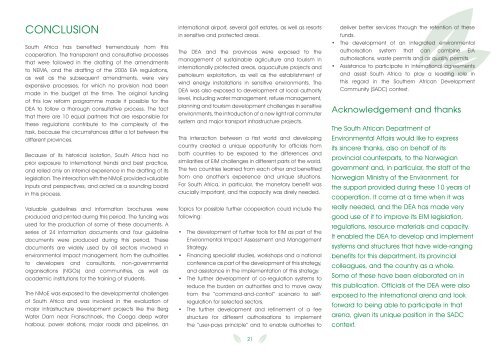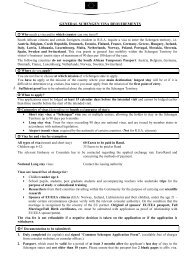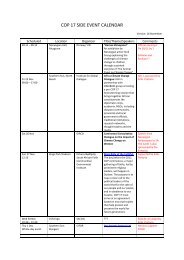Environmental impact management and planning: - Norway
Environmental impact management and planning: - Norway
Environmental impact management and planning: - Norway
You also want an ePaper? Increase the reach of your titles
YUMPU automatically turns print PDFs into web optimized ePapers that Google loves.
CONCLUSIONSouth Africa has benefited tremendously from thiscooperation. The transparent <strong>and</strong> consultative processesthat were followed in the drafting of the amendmentsto NEMA, <strong>and</strong> the drafting of the 2006 EIA regulations,as well as the subsequent amendments, were veryexpensive processes, for which no provision had beenmade in the budget at the time. The original fundingof this law reform programme made it possible for theDEA to follow a thorough consultative process. The factthat there are 10 equal partners that are responsible forthese regulations contribute to the complexity of thetask, because the circumstances differ a lot between thedifferent provinces.Because of its historical isolation, South Africa had noprior exposure to international trends <strong>and</strong> best practice,<strong>and</strong> relied only on internal experience in the drafting of itslegislation. The interaction with the NMoE provided valuableinputs <strong>and</strong> perspectives, <strong>and</strong> acted as a sounding boardin this process.Valuable guidelines <strong>and</strong> information brochures wereproduced <strong>and</strong> printed during this period. The funding wasused for the production of some of these documents. Aseries of 24 information documents <strong>and</strong> four guidelinedocuments were produced during this period. Thesedocuments are widely used by all sectors involved inenvironmental <strong>impact</strong> <strong>management</strong>, from the authoritiesto developers <strong>and</strong> consultants, non-governmentalorganisations (NGOs) <strong>and</strong> communities, as well asacademic institutions for the training of students.The NMoE was exposed to the developmental challengesof South Africa <strong>and</strong> was involved in the evaluation ofmajor infrastructure development projects like the BergWater Dam near Franschhoek, the Coega deep waterharbour, power stations, major roads <strong>and</strong> pipelines, aninternational airport, several golf estates, as well as resortsin sensitive <strong>and</strong> protected areas.The DEA <strong>and</strong> the provinces were exposed to the<strong>management</strong> of sustainable agriculture <strong>and</strong> tourism ininternationally protected areas, aquaculture projects <strong>and</strong>petroleum exploitation, as well as the establishment ofwind energy installations in sensitive environments. TheDEA was also exposed to development at local authoritylevel, including water <strong>management</strong>, refuse <strong>management</strong>,<strong>planning</strong> <strong>and</strong> tourism development challenges in sensitiveenvironments, the introduction of a new light rail commutersystem <strong>and</strong> major transport infrastructure projects.This interaction between a first world <strong>and</strong> developingcountry created a unique opportunity for officials fromboth countries to be exposed to the differences <strong>and</strong>similarities of EIM challenges in different parts of the world.The two countries learned from each other <strong>and</strong> benefitedfrom one another’s experience <strong>and</strong> unique situations.For South Africa, in particular, the monetary benefit wascrucially important, <strong>and</strong> the capacity was direly needed.Topics for possible further cooperation could include thefollowing:• The development of further tools for EIM as part of the<strong>Environmental</strong> Impact Assessment <strong>and</strong> ManagementStrategy.• Financing specialist studies, workshops <strong>and</strong> a nationalconference as part of the development of this strategy,<strong>and</strong> assistance in the implementation of this strategy.• The further development of co-regulation systems toreduce the burden on authorities <strong>and</strong> to move awayfrom the “comm<strong>and</strong>-<strong>and</strong>-control” scenario to selfregulationfor selected sectors.• The further development <strong>and</strong> refinement of a feestructure for different authorisations to implementthe “user-pays principle” <strong>and</strong> to enable authorities todeliver better services through the retention of thesefunds.• The development of an integrated environmentalauthorisation system that can combine EIAauthorisations, waste permits <strong>and</strong> air quality permits.• Assistance to participate in international agreements<strong>and</strong> assist South Africa to play a leading role inthis regard in the Southern African DevelopmentCommunity (SADC) context.Acknowledgement <strong>and</strong> thanksThe South African Department of<strong>Environmental</strong> Affairs would like to expressits sincere thanks, also on behalf of itsprovincial counterparts, to the Norwegiangovernment <strong>and</strong>, in particular, the staff of theNorwegian Ministry of the Environment, forthe support provided during these 10 years ofcooperation. It came at a time when it wasreally needed, <strong>and</strong> the DEA has made verygood use of it to improve its EIM legislation,regulations, resource materials <strong>and</strong> capacity.It enabled the DEA to develop <strong>and</strong> implementsystems <strong>and</strong> structures that have wide-rangingbenefits for this department, its provincialcolleagues, <strong>and</strong> the country as a whole.Some of these have been elaborated on inthis publication. Officials of the DEA were alsoexposed to the international arena <strong>and</strong> lookforward to being able to participate in thatarena, given its unique position in the SADCcontext.21







